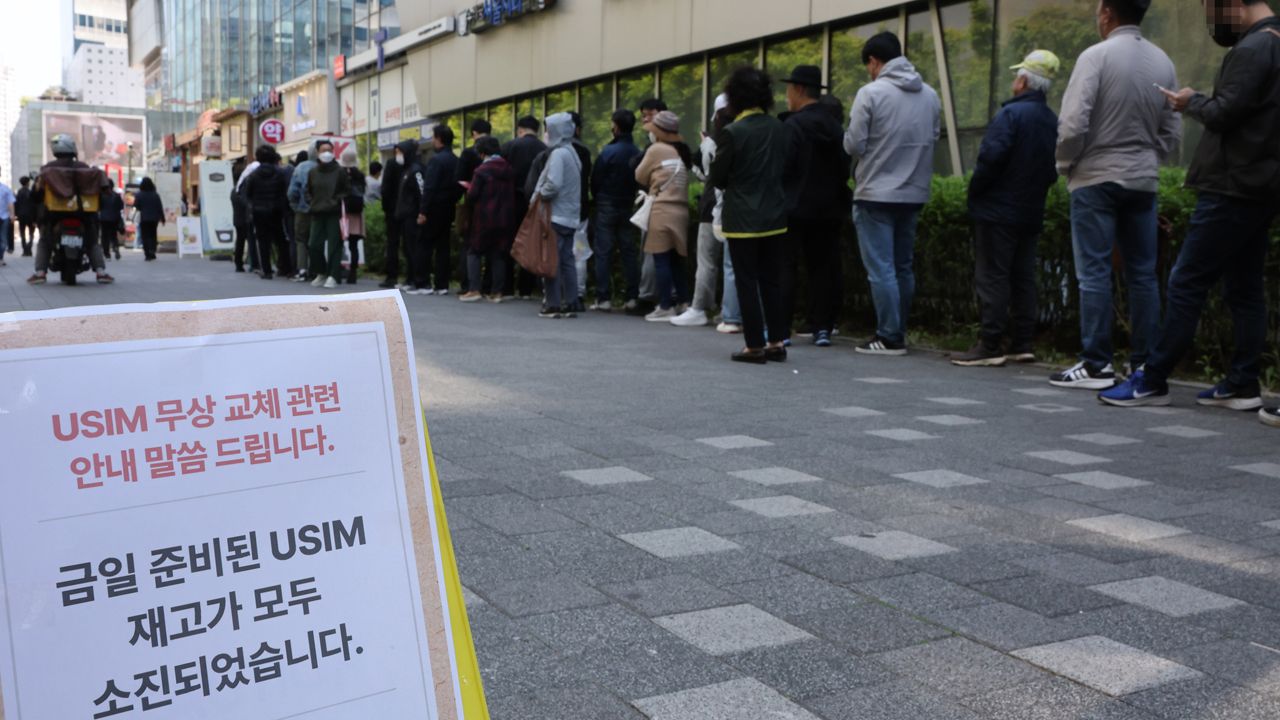[Anchor]
If you have this one thing, you can easily finish a bowl of rice.
The essence of umami, seaweed is gaining great popularity overseas these days.
As a result, unlicensed seaweed farms are popping up everywhere.
To see if enforcement is being properly conducted, reporter Heo Jae-hee visited Wando, the main production area for seaweed.
[Report]
From the sky, the waters off Wando are densely packed with seaweed farming facilities.
However, when comparing photos taken by the coast guard with the fishing ground maps, unlicensed farming facilities outside the yellow zones were identified.
We requested information disclosure from Jeollanam-do Province, which accounts for 80% of the country's seaweed production, to check the area of unlicensed farms.
In Goheung and Wando, where the farming area is the largest, the unlicensed area accounted for more than half of the total, and when adding the areas of seven cities and counties, 40% of Jeollanam-do's farms are unlicensed.
That makes up to one-third the size of Seoul.
As Korean seaweed gains popularity overseas, unlicensed farming has significantly increased, leading to a 27% rise in seaweed production compared to the same period last year.
However, with the number of processing factories remaining the same, the influx of product resulted in 1,200 tons of unprocessed seaweed being discarded into the sea this year.
[Lee Min-soo/Songho Village, Haenam County: "If a large-scale farming area produces seaweed illegally, small-scale, livelihood-based farmers like us inevitably get affected."]
Despite the increase in illegal farms, enforcement remains insufficient.
In Goheung, only about 1% of the total unlicensed area has been detected, and the detection area in other cities and counties is also in single digits percentages.
[Jeon Chang-woo/Director of Eco-Friendly Fisheries, Jeollanam-do: "We only have three patrol boats... If we can't catch them in the act, it's very difficult to take action against them..."]
It was only after the large-scale disposal of seaweed that the Ministry of Oceans and Fisheries and Jeollanam-do begin to seek measures to restore order in the fishing industry.
This is KBS News, Heo Jae-hee.
If you have this one thing, you can easily finish a bowl of rice.
The essence of umami, seaweed is gaining great popularity overseas these days.
As a result, unlicensed seaweed farms are popping up everywhere.
To see if enforcement is being properly conducted, reporter Heo Jae-hee visited Wando, the main production area for seaweed.
[Report]
From the sky, the waters off Wando are densely packed with seaweed farming facilities.
However, when comparing photos taken by the coast guard with the fishing ground maps, unlicensed farming facilities outside the yellow zones were identified.
We requested information disclosure from Jeollanam-do Province, which accounts for 80% of the country's seaweed production, to check the area of unlicensed farms.
In Goheung and Wando, where the farming area is the largest, the unlicensed area accounted for more than half of the total, and when adding the areas of seven cities and counties, 40% of Jeollanam-do's farms are unlicensed.
That makes up to one-third the size of Seoul.
As Korean seaweed gains popularity overseas, unlicensed farming has significantly increased, leading to a 27% rise in seaweed production compared to the same period last year.
However, with the number of processing factories remaining the same, the influx of product resulted in 1,200 tons of unprocessed seaweed being discarded into the sea this year.
[Lee Min-soo/Songho Village, Haenam County: "If a large-scale farming area produces seaweed illegally, small-scale, livelihood-based farmers like us inevitably get affected."]
Despite the increase in illegal farms, enforcement remains insufficient.
In Goheung, only about 1% of the total unlicensed area has been detected, and the detection area in other cities and counties is also in single digits percentages.
[Jeon Chang-woo/Director of Eco-Friendly Fisheries, Jeollanam-do: "We only have three patrol boats... If we can't catch them in the act, it's very difficult to take action against them..."]
It was only after the large-scale disposal of seaweed that the Ministry of Oceans and Fisheries and Jeollanam-do begin to seek measures to restore order in the fishing industry.
This is KBS News, Heo Jae-hee.
■ 제보하기
▷ 카카오톡 : 'KBS제보' 검색, 채널 추가
▷ 전화 : 02-781-1234, 4444
▷ 이메일 : kbs1234@kbs.co.kr
▷ 유튜브, 네이버, 카카오에서도 KBS뉴스를 구독해주세요!
- Illegal seaweed farming
-
- 입력 2025-04-28 01:29:00

[Anchor]
If you have this one thing, you can easily finish a bowl of rice.
The essence of umami, seaweed is gaining great popularity overseas these days.
As a result, unlicensed seaweed farms are popping up everywhere.
To see if enforcement is being properly conducted, reporter Heo Jae-hee visited Wando, the main production area for seaweed.
[Report]
From the sky, the waters off Wando are densely packed with seaweed farming facilities.
However, when comparing photos taken by the coast guard with the fishing ground maps, unlicensed farming facilities outside the yellow zones were identified.
We requested information disclosure from Jeollanam-do Province, which accounts for 80% of the country's seaweed production, to check the area of unlicensed farms.
In Goheung and Wando, where the farming area is the largest, the unlicensed area accounted for more than half of the total, and when adding the areas of seven cities and counties, 40% of Jeollanam-do's farms are unlicensed.
That makes up to one-third the size of Seoul.
As Korean seaweed gains popularity overseas, unlicensed farming has significantly increased, leading to a 27% rise in seaweed production compared to the same period last year.
However, with the number of processing factories remaining the same, the influx of product resulted in 1,200 tons of unprocessed seaweed being discarded into the sea this year.
[Lee Min-soo/Songho Village, Haenam County: "If a large-scale farming area produces seaweed illegally, small-scale, livelihood-based farmers like us inevitably get affected."]
Despite the increase in illegal farms, enforcement remains insufficient.
In Goheung, only about 1% of the total unlicensed area has been detected, and the detection area in other cities and counties is also in single digits percentages.
[Jeon Chang-woo/Director of Eco-Friendly Fisheries, Jeollanam-do: "We only have three patrol boats... If we can't catch them in the act, it's very difficult to take action against them..."]
It was only after the large-scale disposal of seaweed that the Ministry of Oceans and Fisheries and Jeollanam-do begin to seek measures to restore order in the fishing industry.
This is KBS News, Heo Jae-hee.
If you have this one thing, you can easily finish a bowl of rice.
The essence of umami, seaweed is gaining great popularity overseas these days.
As a result, unlicensed seaweed farms are popping up everywhere.
To see if enforcement is being properly conducted, reporter Heo Jae-hee visited Wando, the main production area for seaweed.
[Report]
From the sky, the waters off Wando are densely packed with seaweed farming facilities.
However, when comparing photos taken by the coast guard with the fishing ground maps, unlicensed farming facilities outside the yellow zones were identified.
We requested information disclosure from Jeollanam-do Province, which accounts for 80% of the country's seaweed production, to check the area of unlicensed farms.
In Goheung and Wando, where the farming area is the largest, the unlicensed area accounted for more than half of the total, and when adding the areas of seven cities and counties, 40% of Jeollanam-do's farms are unlicensed.
That makes up to one-third the size of Seoul.
As Korean seaweed gains popularity overseas, unlicensed farming has significantly increased, leading to a 27% rise in seaweed production compared to the same period last year.
However, with the number of processing factories remaining the same, the influx of product resulted in 1,200 tons of unprocessed seaweed being discarded into the sea this year.
[Lee Min-soo/Songho Village, Haenam County: "If a large-scale farming area produces seaweed illegally, small-scale, livelihood-based farmers like us inevitably get affected."]
Despite the increase in illegal farms, enforcement remains insufficient.
In Goheung, only about 1% of the total unlicensed area has been detected, and the detection area in other cities and counties is also in single digits percentages.
[Jeon Chang-woo/Director of Eco-Friendly Fisheries, Jeollanam-do: "We only have three patrol boats... If we can't catch them in the act, it's very difficult to take action against them..."]
It was only after the large-scale disposal of seaweed that the Ministry of Oceans and Fisheries and Jeollanam-do begin to seek measures to restore order in the fishing industry.
This is KBS News, Heo Jae-hee.
이 기사가 좋으셨다면
-
좋아요
0
-
응원해요
0
-
후속 원해요
0











![[속보] 대구 산불 서변동으로 확산 중…인근 주민 <br>동변중학교로 대피령](/data/layer/904/2025/04/20250428_0yLPQc.jpg)
![[영상] 대구 북구 산불 계속 확산…1,200명 대피·도로 통제](/data/fckeditor/vod/2025/04/28/295661745827270668.png)
![[속보] 서울 시내버스 30일 파업 예고…서울시, 비상수송대책 마련](/data/layer/904/2025/04/20250428_Ol8Xqq.jpg)


이 기사에 대한 의견을 남겨주세요.